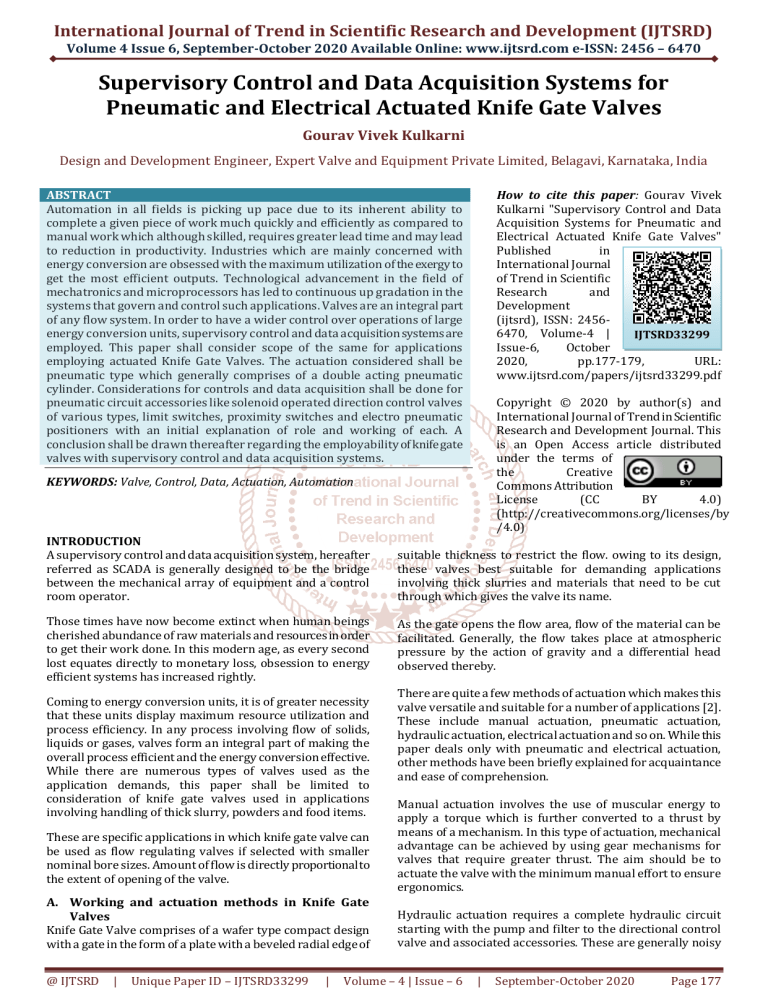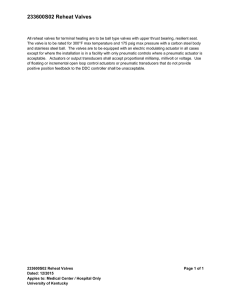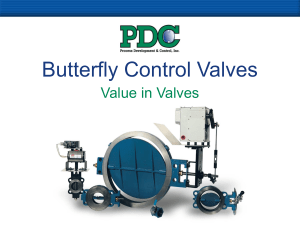
International Journal of Trend in Scientific Research and Development (IJTSRD)
Volume 4 Issue 6, September-October 2020 Available Online: www.ijtsrd.com e-ISSN: 2456 – 6470
Supervisory Control and Data Acquisition Systems for
Pneumatic and Electrical Actuated Knife Gate Valves
Gourav Vivek Kulkarni
Design and Development Engineer, Expert Valve and Equipment Private Limited, Belagavi, Karnataka, India
ABSTRACT
Automation in all fields is picking up pace due to its inherent ability to
complete a given piece of work much quickly and efficiently as compared to
manual work which although skilled, requires greater lead time and may lead
to reduction in productivity. Industries which are mainly concerned with
energy conversion are obsessed with the maximum utilization of the exergy to
get the most efficient outputs. Technological advancement in the field of
mechatronics and microprocessors has led to continuous up gradation in the
systems that govern and control such applications. Valves are an integral part
of any flow system. In order to have a wider control over operations of large
energy conversion units, supervisory control and data acquisition systems are
employed. This paper shall consider scope of the same for applications
employing actuated Knife Gate Valves. The actuation considered shall be
pneumatic type which generally comprises of a double acting pneumatic
cylinder. Considerations for controls and data acquisition shall be done for
pneumatic circuit accessories like solenoid operated direction control valves
of various types, limit switches, proximity switches and electro pneumatic
positioners with an initial explanation of role and working of each. A
conclusion shall be drawn thereafter regarding the employability of knife gate
valves with supervisory control and data acquisition systems.
How to cite this paper: Gourav Vivek
Kulkarni "Supervisory Control and Data
Acquisition Systems for Pneumatic and
Electrical Actuated Knife Gate Valves"
Published
in
International Journal
of Trend in Scientific
Research
and
Development
(ijtsrd), ISSN: 24566470, Volume-4 |
IJTSRD33299
Issue-6,
October
2020,
pp.177-179,
URL:
www.ijtsrd.com/papers/ijtsrd33299.pdf
Copyright © 2020 by author(s) and
International Journal of Trend in Scientific
Research and Development Journal. This
is an Open Access article distributed
under the terms of
the
Creative
Commons Attribution
License
(CC
BY
4.0)
(http://creativecommons.org/licenses/by
/4.0)
KEYWORDS: Valve, Control, Data, Actuation, Automation
INTRODUCTION
A supervisory control and data acquisition system, hereafter
referred as SCADA is generally designed to be the bridge
between the mechanical array of equipment and a control
room operator.
Those times have now become extinct when human beings
cherished abundance of raw materials and resources in order
to get their work done. In this modern age, as every second
lost equates directly to monetary loss, obsession to energy
efficient systems has increased rightly.
Coming to energy conversion units, it is of greater necessity
that these units display maximum resource utilization and
process efficiency. In any process involving flow of solids,
liquids or gases, valves form an integral part of making the
overall process efficient and the energy conversion effective.
While there are numerous types of valves used as the
application demands, this paper shall be limited to
consideration of knife gate valves used in applications
involving handling of thick slurry, powders and food items.
These are specific applications in which knife gate valve can
be used as flow regulating valves if selected with smaller
nominal bore sizes. Amount of flow is directly proportional to
the extent of opening of the valve.
A. Working and actuation methods in Knife Gate
Valves
Knife Gate Valve comprises of a wafer type compact design
with a gate in the form of a plate with a beveled radial edge of
@ IJTSRD
|
Unique Paper ID – IJTSRD33299
|
suitable thickness to restrict the flow. owing to its design,
these valves best suitable for demanding applications
involving thick slurries and materials that need to be cut
through which gives the valve its name.
As the gate opens the flow area, flow of the material can be
facilitated. Generally, the flow takes place at atmospheric
pressure by the action of gravity and a differential head
observed thereby.
There are quite a few methods of actuation which makes this
valve versatile and suitable for a number of applications [2].
These include manual actuation, pneumatic actuation,
hydraulic actuation, electrical actuation and so on. While this
paper deals only with pneumatic and electrical actuation,
other methods have been briefly explained for acquaintance
and ease of comprehension.
Manual actuation involves the use of muscular energy to
apply a torque which is further converted to a thrust by
means of a mechanism. In this type of actuation, mechanical
advantage can be achieved by using gear mechanisms for
valves that require greater thrust. The aim should be to
actuate the valve with the minimum manual effort to ensure
ergonomics.
Hydraulic actuation requires a complete hydraulic circuit
starting with the pump and filter to the directional control
valve and associated accessories. These are generally noisy
Volume – 4 | Issue – 6
|
September-October 2020
Page 177
International Journal of Trend in Scientific Research and Development (IJTSRD) @ www.ijtsrd.com eISSN: 2456-6470
and consume a greater quantum of energy as compare to
pneumatic actuators.
that at a given time, only one of the coil is energized and the
desired actuation is facilitated.
Having comprehended the basics of actuation, focus can now
be moved to SCADA and its application in context of
pneumatic and electrical actuation systems and associated
accessories.
In the data acquisition systems, separate programmable
modules can be set to automate the overall process such that
on setting up the timing, the solenoid is actuated
automatically and there is minimum human interference.
B. Knife Gate valves with double acting pneumatic
cylinder actuator
Pneumatic double acting cylinder actuators are preferred
when the actuation needs to be done quicker and against
lesser resistance. Such instances involve handling of various
powders and solids of similar consistency.
Direction control valves play a vital role in the direction of the
process. Complete chemical kinetics of the reactions if
applicable depend on the rate and quantity of fluid flowing.
Although there are checks and measures to ensure continuity,
these systems may require periodic maintenance to
guarantee trouble free operation from time to time.
Similar to the hydraulic circuits, pneumatic circuits also
require certain basic circuit elements for adequate
functioning. These include air compressor, air preparation
units and direction control units. Certain additional
accessories may also be included to determine the extent of
opening of the gate which include limit switches, proximity
sensors and electro pneumatic positioners.
D. SCADA for mechanically actuated limit switches
Every electronic system or circuit would be incomplete
without a feedback system. Limit switches play the role of a
feedback system.
A basic pneumatic circuit starts with a source which can be
an air compressor tank or an accumulator tank. Thereafter
air preparation units like air filter, pressure regulator and
lubricator condition the air to suit the application
requirements. Conditioned air is then passed through the
direction control valve which ensures appropriate actuation
of the pneumatic actuator.
SCADA is most effective when all these accessories are
connected in tandem to deliver a specifically defined
operation. In the following sections, the same shall be
discussed in depth. The role of each of these accessories shall
be known at first after which controls and data acquisition for
each shall be discussed.
C. SCADA for control of solenoid operated direction
control valves of various types
Direction control valves in a pneumatic circuit facilitate the
channelizing of compressed air so that the actuation action
can take place accordingly. These valves come with a number
of variants. Firstly, with regards to actuation, these may be
pilot operated, cam operated, solenoid operated and so on.
This paper shall consider only the solenoid operated
direction control valves.
Direction control valves are further specified by the number
of ports and the number of positions. For example, a 5/2
solenoid operated direction control valve refers to a direction
control valve with five ports, two positions; one each for open
and close operated or actuated by a solenoid coil. Depending
on the application, one may employ 3/2 or for that matter
5/3 direction control valves where one of the ports may be
permanently shut to ensure stay put condition.
As stated earlier, since solenoid operated direction control
valve is primarily controlled by electrical energy, SCADA can
be introduced to control the actuation of the coil. This is
related to the number of positions of the direction control
valve. For single coil solenoid valves, the logic may be such
that energizing the coil may indicate the open position while
de-energizing may indicate the close position and vice versa.
In case of double coil solenoid valves, logic can be set such
@ IJTSRD
|
Unique Paper ID – IJTSRD33299
|
There are times when the valve is located at a remote
location from the observer's chamber. At such times, one can
solely rely on feedback systems to know the current status of
the valve.
Limit switches are connected in the feedback system such
that it can be known whether the valve is open or closed. This
can facilitate immediate action as and when required.
Mechanically actuated limit switches comprise of an internal
signal providing circuit that is either opened or closed by
actuating a switch by mechanical action. This actuation may
be by a roller or a protrusion on the gate. Limit switches are
generally employed in pairs where one indicates a normally
open position while the other indicates a normally closed
position.
SCADA can be integrated with solenoid operated direction
control valves and mechanically actuated limit switches to
develop different kinds of circuits like switching circuits,
continuous open close actuation circuits, limit circuits and so
on.
Data acquisition systems can record the frequency of
operation and can pave way to sustainable developments in
the process such that streamlining of activities is facilitated
with effective elimination of bottle necks at distinguished
stages.
E. SCADA for inductive proximity switches or
sensors
These are used in lieu of limit switches wherever necessary.
Unlike mechanically actuated limit switches, these switches
do not have any contact parts and work on the principle of
electromagnetic induction.
Similar to limit switches, these also are employed as normally
open and normally closed switches. These switches can be
customized largely to suit specific requirements of the
application.
Similar circuits can be designed as that for limit switches with
the help of SCADA and it can serve as an efficient indicator of
the instantaneous condition of the valve.
Volume – 4 | Issue – 6
|
September-October 2020
Page 178
International Journal of Trend in Scientific Research and Development (IJTSRD) @ www.ijtsrd.com eISSN: 2456-6470
F. SCADA for electro pneumatic positioners
The accessories discussed till this point have something in
common. It is that all these can ensure only complete opening
or closing of the valve but cannot facilitate intermediate
opening. Initially, it is necessary to know why intermediate
opening may be required. Applications that involve
controlled flow of powders of all kinds, crystals and materials
like spent grain and husky items, it may be required at times
that the gate is opened for a certain predetermined
percentage opening to allow calculated amount of charge for
further processing. It would be quite a difficult task to
calibrate the systems to carry out this feat in the absence of
an electro pneumatic positioner.
Electro pneumatic positioner can perform as a direction
control valve, limit switch and as a hand held valve actuation
device. This versatility of these devices make them a much
sought after accessory in the pneumatic actuated valves.
As a direction control valve, the positioner is connected to the
pneumatic cylinder by means of tubing to control the flow of
air. A correctly designed pneumatic circuit can ensure
relation between the display on the positioner and the
actuation of the double acting pneumatic cylinder.
Since the positioner can accurately indicate the instantaneous
location of gate opening or opening percentage, it can easily
discharge the duties of a limit switch. However, switching
circuits may have to be programmed separately in the SCADA
interface.
There are two main types of electro pneumatic positioners.
First are manually calibrated and the second are smart type.
Manually calibrated positioners require the operator to
define the limits and intermediate positions while smart
positioners have the facility of auto calibration. Both are
equally effective and can be employed as the application
demands.
SCADA for electro pneumatic positioners can be initialized to
ensure desired opening of the gate as and when required
according to the need of the application. Flexibility in
actuation at will can be easily and sufficiently demonstrated
by such systems.
Data acquisition systems can very well ensure the repetitive
behaviour of the system in terms of the extents of opening
and the correlation of the same with the process being
carried out in the line.
@ IJTSRD
|
Unique Paper ID – IJTSRD33299
|
G. SCADA for Electrical actuators
Electrical actuators are basically induction motors that can be
controlled to apply a desired torque. These generally come
with inbuilt limit switches and torque switches for fine tuning
as per the line requirements and application specifications.
SCADA for these systems can be employed with limit switches
or proximity sensors to know the instantaneous position of
the gate.
Data acquisition systems can be helpful to know the variation
in the applied torque and thereby thrust to actuate the gate
against variable line pressure. This can help in designing
optimized systems to ensure applicability for a wider range of
process parameters.
Conclusion
Thus it can be concluded that for implementation of
supervisory control and data acquisition systems for
applications employing actuated knife gate valves, the basic
idea of SCADA and data acquisition systems has been
enumerated with regards to pneumatic circuits with various
accessories and electrical circuits. Findings can be helpful in
designing customized solutions for dedicated applications
with optimum design considerations.
Acknowledgement
The author thanks Management and Staff of Expert Valve and
Equipment Private Limited, Belagavi, Karnataka for their
continuous support and inputs to come up with this work.
References
[1] Gourav Vivek Kulkarni | Divya Rajendra Lagmavar
"Qualitative Design of Supervisory Control and Data
Acquisition System for a Regenerative Type Heat
Exchanger" Published in International Journal of Trend
in Scientific Research and Development (ijtsrd), ISSN:
24566470, Volume-4 | Issue-1, December 2019,
pp.884-886
[2] Gourav Vivek Kulkarni "Qualitative Study to Check
Feasibility of Knife Gate Valves for High Working and
Testing Pressures" Published in International Journal
of Trend in Scientific Research and Development
(ijtsrd), ISSN: 24566470, Volume-4 | Issue-5, August
2020, pp.1361-1364
Volume – 4 | Issue – 6
|
September-October 2020
Page 179





